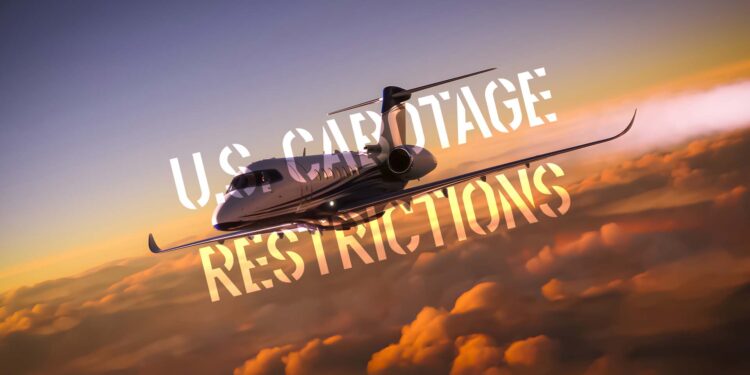U.S. Cabotage Restrictions – non-U.S. Business Aircraft Considerations

Cabotage restrictions have an impact on operations of non-U.S. registered business aircraft within the U.S. These rules and limitations, however, are often not well understood by general aviation (GA) operators. Consequences of non-compliance include Department of Transport (DOT) findings of violations, and potential order to cease and desist, as well as civil penalties of up to $27,500 per violation.
The following is an overview of what you need to know:
1. U.S. cabotage basics
Cabotage is carriage of revenue traffic by foreign-registered carriers between two U.S. points, other than as part of a through trip (with the same carrier) involving travel to/from a foreign point. Cabotage has long been banned by U.S. law – 49 U.S.C. and 41703 and 294.81 of DOT’s Economic Regulations – except in certain emergency situations. Cabotage prohibitions are strictly enforced by the DOT. Note that these rules apply to charter (non-scheduled commercial) operations but not to private non-revenue flights. In the case of charter flights, it is permissible for non-U.S. registered aircraft to move passengers between two points in the U.S., so long as these passengers either arrive in the U.S. aboard the aircraft or depart the U.S. with the same aircraft.
2. Cabotage rules cover all U.S. territories
For cabotage purposes “United States” includes all U.S. territories. Therefore, a foreign-registered carrier is not permitted to carry revenue passengers solely within American Samoa or between American Samoa and Honolulu. These would be considered cabotage violations.
3. Enforcement of rules
DOT defines U.S. cabotage restrictions and creates the relevant regulations. But, it’s U.S. Customs and Border Protection (CBP) that monitors and enforces cabotage. CBP rules require customs officers to report suspected cabotage violations, and in practice, CBP is very strict on cabotage regulation. Be aware that if you’re operating a charter flight within the U.S., CBP must always be notified of crew and passenger information for each flight leg in the U.S. Once CBP reviews the crew and passenger information and if there are no cabotage violations, CBP will issue a “permit to proceed” for the next leg of the flight. A “permit to proceed” is a stamp on the general declaration (gen dec) for each particular port to port leg. All non-U.S. registered charter flights must comply with these “permit to proceed” requirements.
4. Permits to proceed process and penalties
It’s important that operators of non-U.S. registered charters be aware of “permit to proceed” requirements and the process of obtaining this permit. After obtaining your “permit to proceed” a log number will be issued and CBP monitors this to determine if the operator has the appropriate permits for traveling internally. If you do not have the required “permit to proceed” – especially if you’re a repeat offender – fines may be levied, and/or you may be grounded or banned from future operation to the U.S. Note that fines for operating in the U.S. without a permit to proceed, in some cases, may not be imposed until months after the operation.
5. Payment of CBP fines
All operators of foreign-registered charter aircraft flying to the U.S. must have customs bonds. Penalties incurred as a result of not having a “permit to proceed” will be charged against your customs bond. If a suspected cabotage infraction takes place you’ll first receive a notice of intent for a fine and be given a specific amount of time to submit a letter of defense. If it’s determined that the fine is valid, CBP will then obtain payment from your customs bond.
6. Cabotage infractions on the day of operation
If CBP at a particular port determines that cabotage may take place they’ll not permit the passenger(s) in question to board the aircraft. The aircraft must then depart without the passenger(s) in question. As a general rule charter operators may not pick up passengers in the U.S. and drop them at another location within the U.S., unless the passenger(s) are continuing on with the same aircraft to a point outside the U.S. (Single Continuous International Journey).
7. Exemptions for cabotage
There are a few exemptions available, to allow operations that would otherwise be considered cabotage. It’s always recommended, however, that operators speak with an aviation lawyer to gain better understanding of available options. In most cases these exemptions aren’t given to operators. Note that DOT is the only entity able to provide these exemptions.
8. Permits for non-U.S. non-scheduled commercial flights
Form 375 allows 6-12 charter flights into/out of the U.S. per year. For more than 12 charter operations per year to the U.S. you’ll need to apply for Form 129 permission. For Mexican-registered charter operators, 49.1SC provides an permission to travel to/from the U.S. Note that these permissions are to be able to travel to and from the U.S. as a non-scheduled commercial flight but doesn’t provide exemption for cabotage.
9. Determining if your flight involves cabotage
Cabotage within the U.S. is only a consideration for non-U.S. registered charter operators, as these regulations do not apply to non-U.S. registered private non-revenue flights. It’s always best to speak to your 3rd-party provider to gain clarity on what does and does not constitute cabotage within the U.S.
10. An example of cabotage
Cabotage regulations in the U.S. focus on the movement of each passenger separately. If five passengers arrive in the U.S. on a foreign-registered non-scheduled commercial aircraft, from a foreign point (outside the U.S.), and two passengers join the flight at a U.S. point and depart at another U.S. point to be dropped off, then two cabotage violations have occurred. Note that it’s not relevant to cabotage findings on the reasons for the passenger’s trip, citizenship of the passengers, source of payment for the flight and/or whether the flight was arranged and paid for outside the U.S.
11. More information on U.S. cabotage
It’s always a good idea to check U.S. DOT’s website to gain general information on U.S. cabotage regulations/restrictions. You may also check CBP’s website for information on “permits to proceed,” although there’s not a great deal of information available. Best practice is to communicate with your 3rd-party provider to determine if a cabotage violation is likely based on your particular non-scheduled commercial flight scenario within the U.S.
Conclusion
Charter operators of non-U.S. registered aircraft are responsible for understanding and complying with all regulations and restrictions pertaining to U.S. cabotage. If you’re unsure of these regulations/restrictions it’s best to discuss this with your 3rd-party provider. Once the implications of cabotage as they pertain to your particular trip are clear, it’s a good idea to communicate with your passengers to let them know how this may limit their ability to pick up, drop off and carry personnel locally between U.S. points.
Questions?
If you have any questions about this article or would like assistance regarding aviation regulatory issues, contact us at lauraeverington@univ-wea.com or juanmuniz@univ-wea.com.




